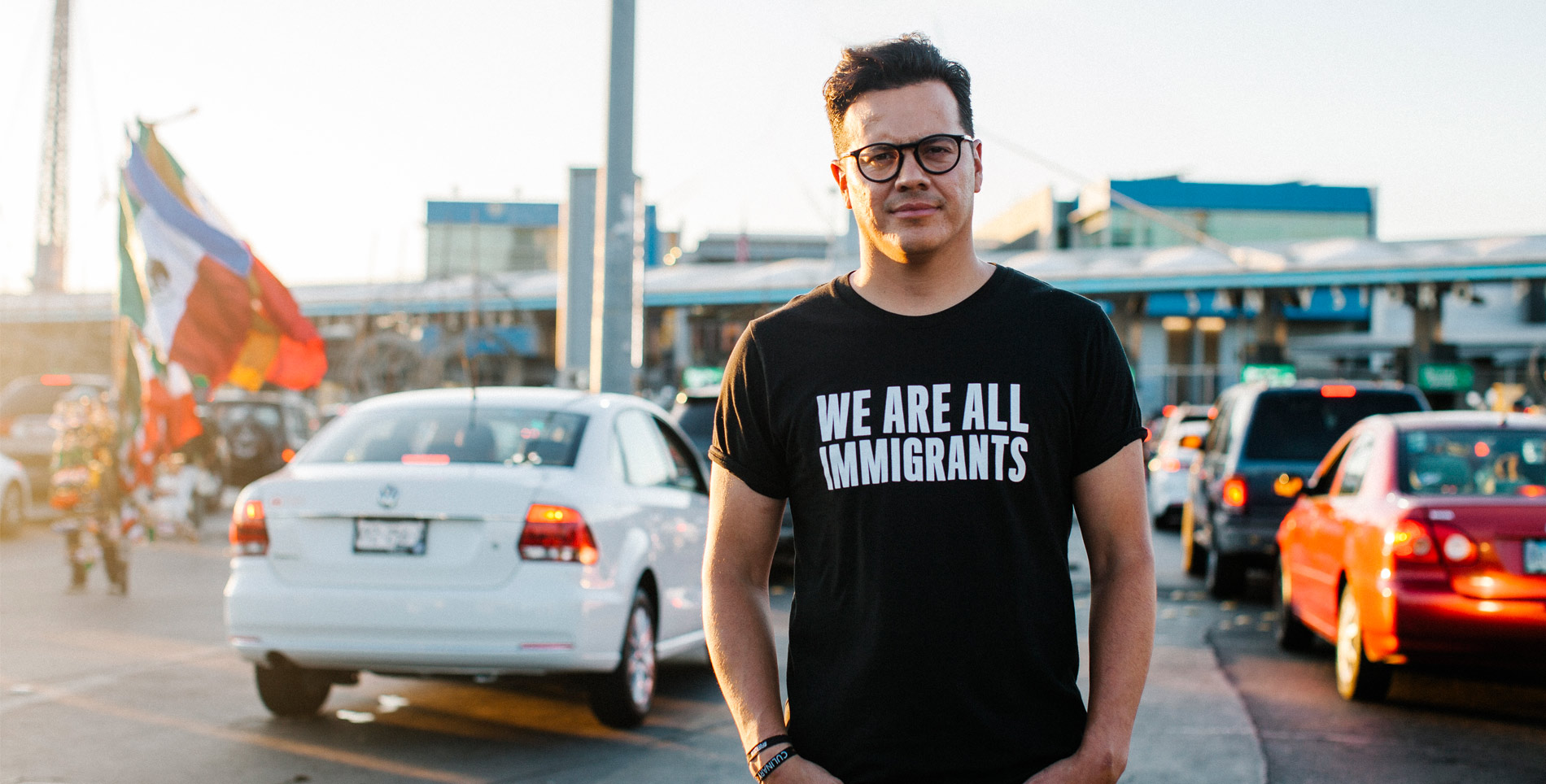
Nov. 5, 2019 — Mexico
ROOTED ON THE BORDER:
Tijuana’s Culinary Art School Alumni Define Modern Baja Cuisine
Words by Ferron Salniker
Photography by Samanta Helou Hernandez
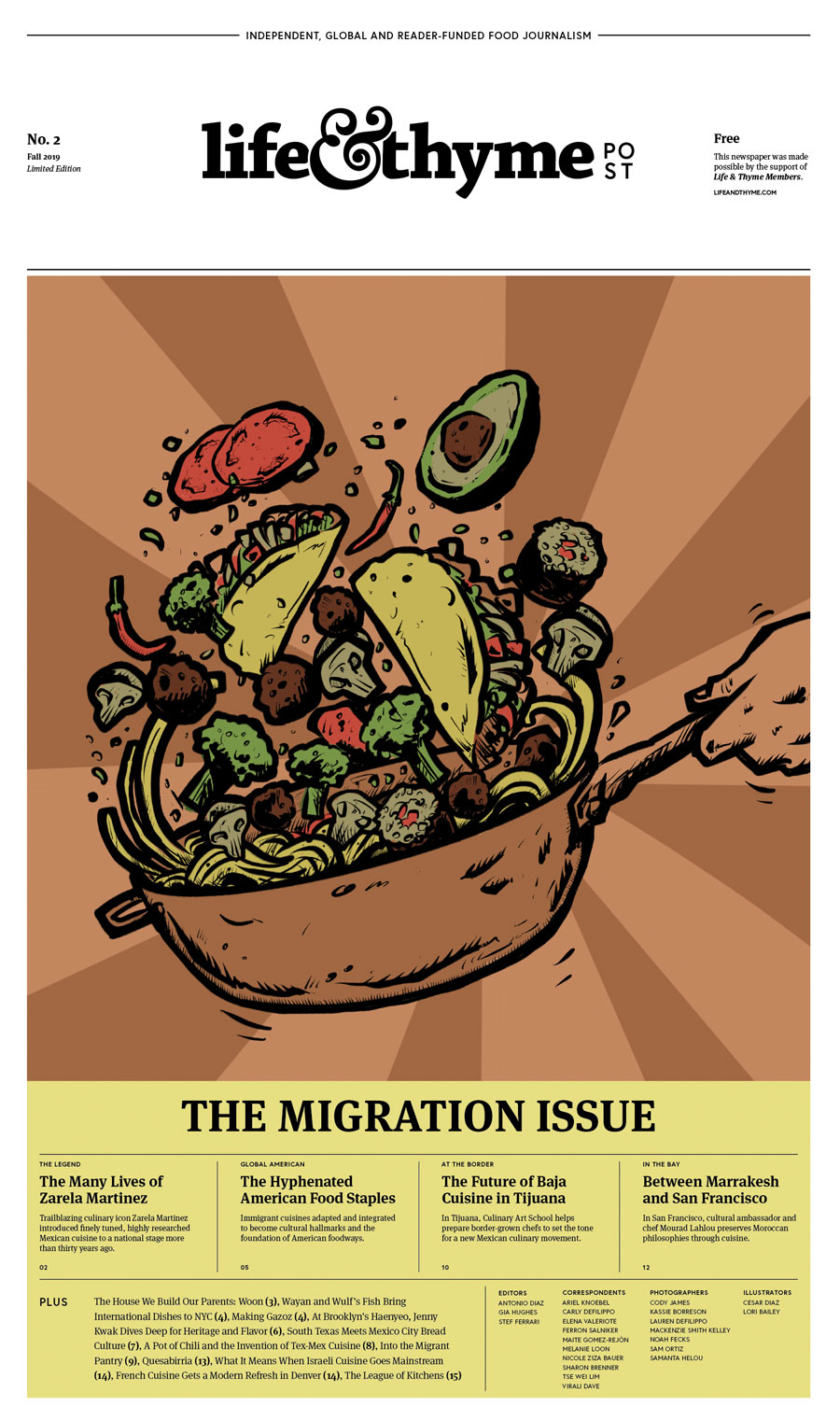
This story can also be found in The Migration Issue of Life & Thyme Post, our limited edition newspaper for Life & Thyme members.
On a Friday night at Oryx Capital in Tijuana, chef Ruffo Ibarra is plating pulpo enchilado, splattering a charcoal plate with neon sauces like a Jackson Pollock. The dish is inspired by a local Sinaloan-style taqueria’s octopus taco, the sauces representing some of its essential accompaniments: bright yellow escabeche, orange adobo, and a green cilantro. He tops the purple tentacles with a crispy ode to the tortilla: a corn chicharrón.
Ibarra is a rising chef in Tijuana. This year his restaurant earned reader’s pick for San Diego Magazine’s best restaurant in Baja and his Prohibition-themed speakeasy, Noritco, is leading the city’s cocktail scene. It’s tucked behind the restaurant, a moody den with gold accents and sepia photos of Tijuana’s “golden age” when booze-thirsty Americans crossed the border for a glitzy casino and other debaucherous thrills. Before well-dressed crowds head for craft cocktails, they might try the steak dish, a nod to the California Gold Rush with intentionally rich flavors—truffled mashed potatoes, mushrooms and bone marrow delicately crowned with pea shoots and gold-dusted “potato crystals” that look like fantastical underwater sea creatures. Ibarra’s dishes have a splashy and wandering quality to them, revealing Baja and California, and the imaginations of the border kids who grow up between the two.
In this time of increasing political barriers, it’s precisely the blend of different cultures and influences that contributes to Northern Baja’s modern cuisine and its recent hype. In the past few years, press recognition of the city as a culinary destination have beckoned foodies to Tijuana’s high-end restaurants and food truck parks, as well as wine mecca Valle de Guadalupe. While a few big-name chefs can be pointed to as trailblazers of the area’s modern cuisine, the foot soldiers of this movement are a young generation of border-bred chefs. From San Diego to Ensenada, a review of the roster of Baja restaurants reveals many began their careers at Tijuana’s Culinary Art School, the first culinary school in Northwestern Mexico and a place where young chefs use the kitchen to break down walls.
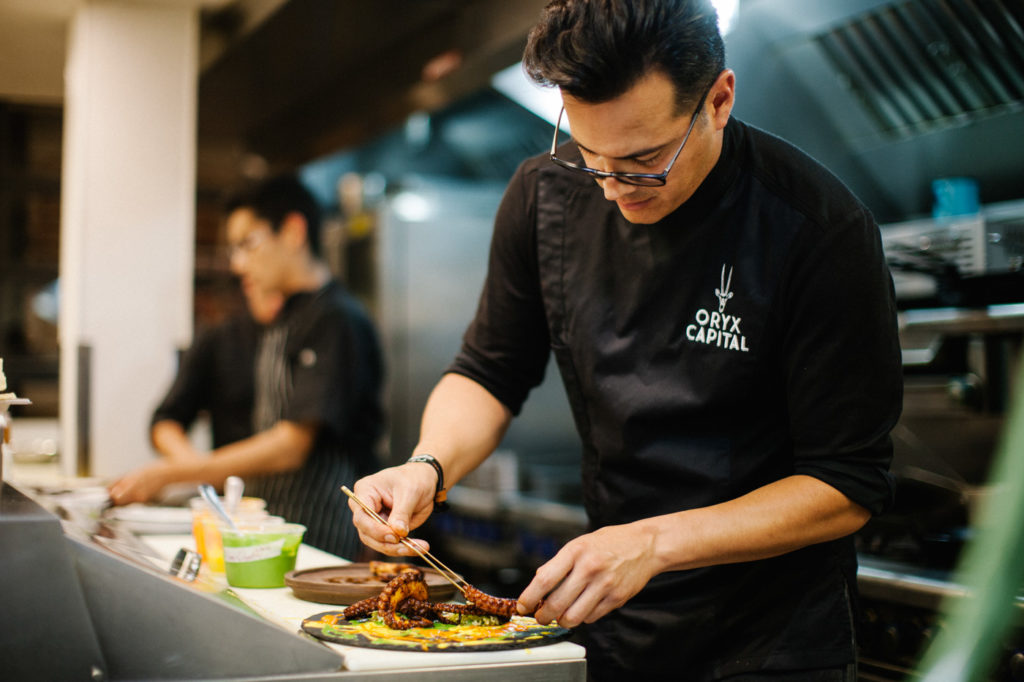

“The fun thing about Baja is we get to take all of the flavors and traditions of Mexico and play with them. There are no rules here because we aren’t as bound to traditions,” said Ibarra. Baja is an eight hundred-mile-long peninsula that hangs off California and Arizona, separated from mainland Mexico by the Sea of Cortés, and its geography has a lot to do with its distinction and isolation from the rest of Mexico. Many border kids grow up immersed in English television and radio, some are enrolled in U.S. schools, and in many other ways are culturally closer to the U.S. than to the rest of Mexico.
As for its cuisine, the northern half of the peninsula is not like other states in Mexico where centuries-old food traditions have been preserved by generations of mostly indigenous cooks (Oaxaca for instance). The indigenous populations here were mostly nomadic, seasonally following the best ingredients from abalone and seaweed on the Pacific coast to acorns and prickly pears in the sierras and deserts. This style of seasonal eating is still fundamental to modern Baja cuisine.
Culinary Art School sits off the Tijuana River, which as it makes its way to San Diego passes la linea, the world’s busiest land border, where street vendors hustle churros to waiting cars and shoulder giant statues of the Virgin de Guadalupe like devotees on a pilgrimage. South of it is an area that has historically absorbed migrants from all over the country and the world. Sonorans and Sinaloans who made carne asada and tacos de marlin icons of Tijuana’s street corners. Chinese communities whose influence can be found in the tiradito covered in soy sauce. The Japanese fishermen’s tempura techniques that melded with a Mexican frying instrument to birth Ensenada’s signature fish taco. The czar-fleeing Russians who revived the mission’s failed wineries in the Valle de Guadalupe.
Baja Med, a term that ages out as this Mexican food region shakes off the need for a Eurocentric suffix, points to the combination of Mexican cooking with Asian influences, as well as the area’s abundance of Mediterranean-like ingredients. In the early 2000s chefs like Miguel Ángel Guerrero, Javier Plascencia, Jair Tellez and Benito Molino used this label to vocalize a new style of ingredient-centric Baja cuisine coming from their kitchens in Tijuana, Ensenada and the Valle de Guadalupe.
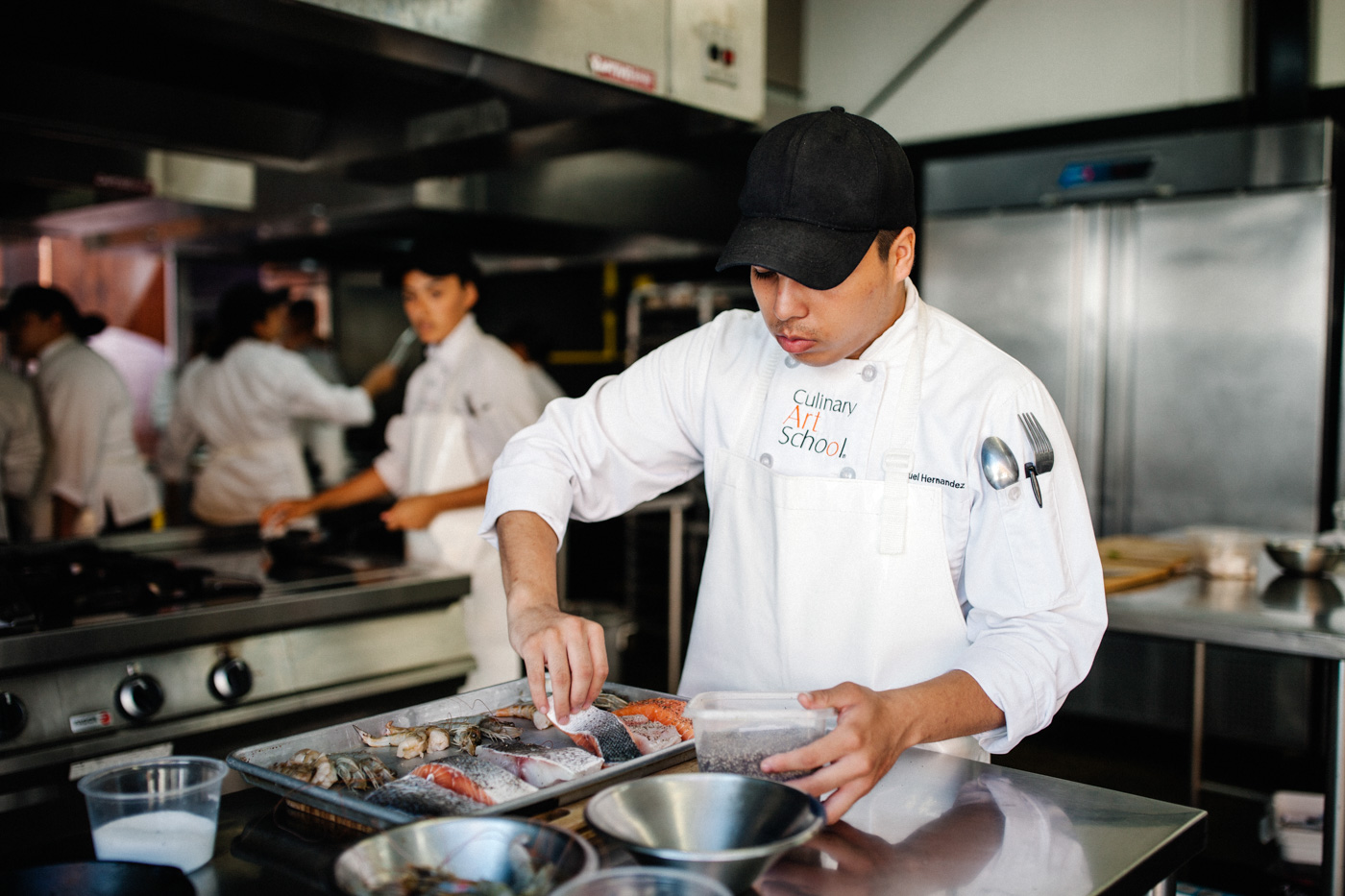
Younger chefs point to these names as idols. “It wasn’t until Culinary Art School opened up that we as the younger generation had any options in the area to pursue culinary studies,” says Ibarra. “They started educating us, and then we started educating our parents and friends. It was the detonator for making Baja a global gastronomic reference.”
Ibarra grew up in Tijuana, the son of a well-known accountant who worked his way up the economic ladder from a janitorial position, and a mother whose cooking kept Ibarra close to the kitchen. He bounced between schools in Tijuana, San Diego and Las Vegas, and then split his days between restaurant shifts in the Baja area as a teenager. After looking at culinary schools across the country, in 2003 he was one of the first students to take a chance on a scrappy new school in a converted Tijuana house. That early generation was made up of chefs like Diego Hernandez of Corazón de Tierra in the Valle de Guadalupe, Guillermo “Oso” Campos whose street-cart turned restaurant Tras/Horizonte might best represent Tijuana’s inventive spirit, and Jose Rodrigo Figueroa Sanchez, the chef behind La Carmelita food truck in Tijuana’s hip Gastropark Telefonica and San Diego-based Corazón de Torta.
“The first workshop was held in a garage,” says director Javier González. “Instead of cars we put in stoves and ovens. The bedrooms were classrooms, the backyard was where we took our coffee and cigarette breaks.”
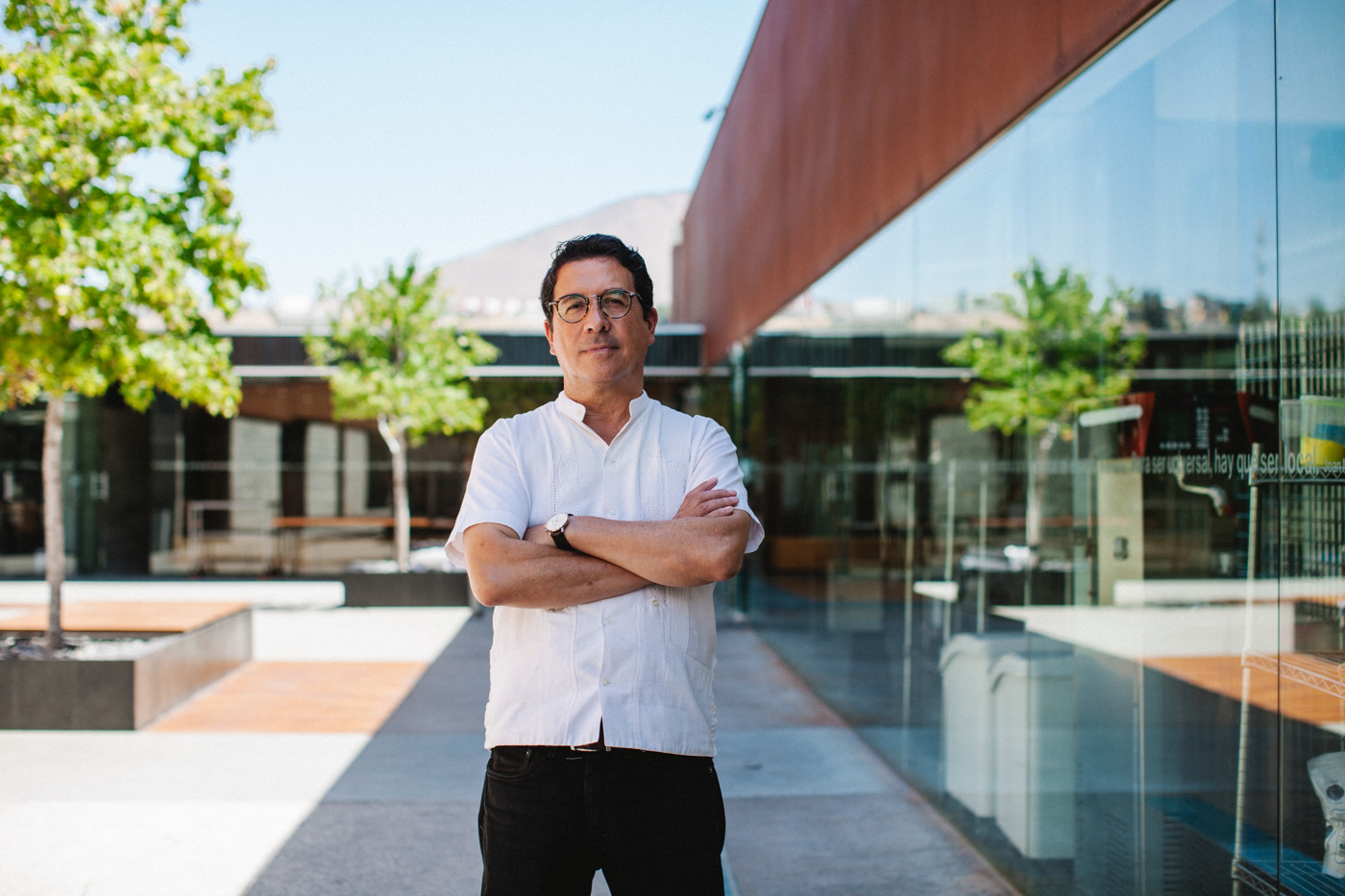
Culinary Art School was opened in 2003 by González and his wife, Ana Laura Martínez. The son of bakery owners, González was born in Mexico City but lived in Tijuana with his family in the 1980s when he developed an affection for the city. Following in his parents’ footsteps, he studied hospitality with a focus on food and beverage. After the couple opened and ran culinary schools in Chile for several years, they were eyeing a return to Mexico. Launching a school in Tijuana seemed like the ticket home.
It was a transitional time for Tijuana and the surrounding region as well. The 9/11 attacks slowed the flow of tourists, and later the country’s drug cartels made the city their frontline. But with the absence of outsiders, entrepreneurial locals began to create a city for themselves. Chefs like Placencia and Guerrero formed the first association of Chefs of Northern Baja California. In the Valle de Guadalupe where there were just a handful of wineries, one of the area’s most renowned winemakers Hugo d’Acosta opened a winemaking school, launching many of the now hundreds of wineries. Meanwhile, a young Baja chef, José Antonio Santoyo García, won a prestigious national contest that sparked a frenzy from the rest of the country over his main ingredient: fresh sea urchin from Ensenada.
“Right place, right time,” says González about opening the school.
——
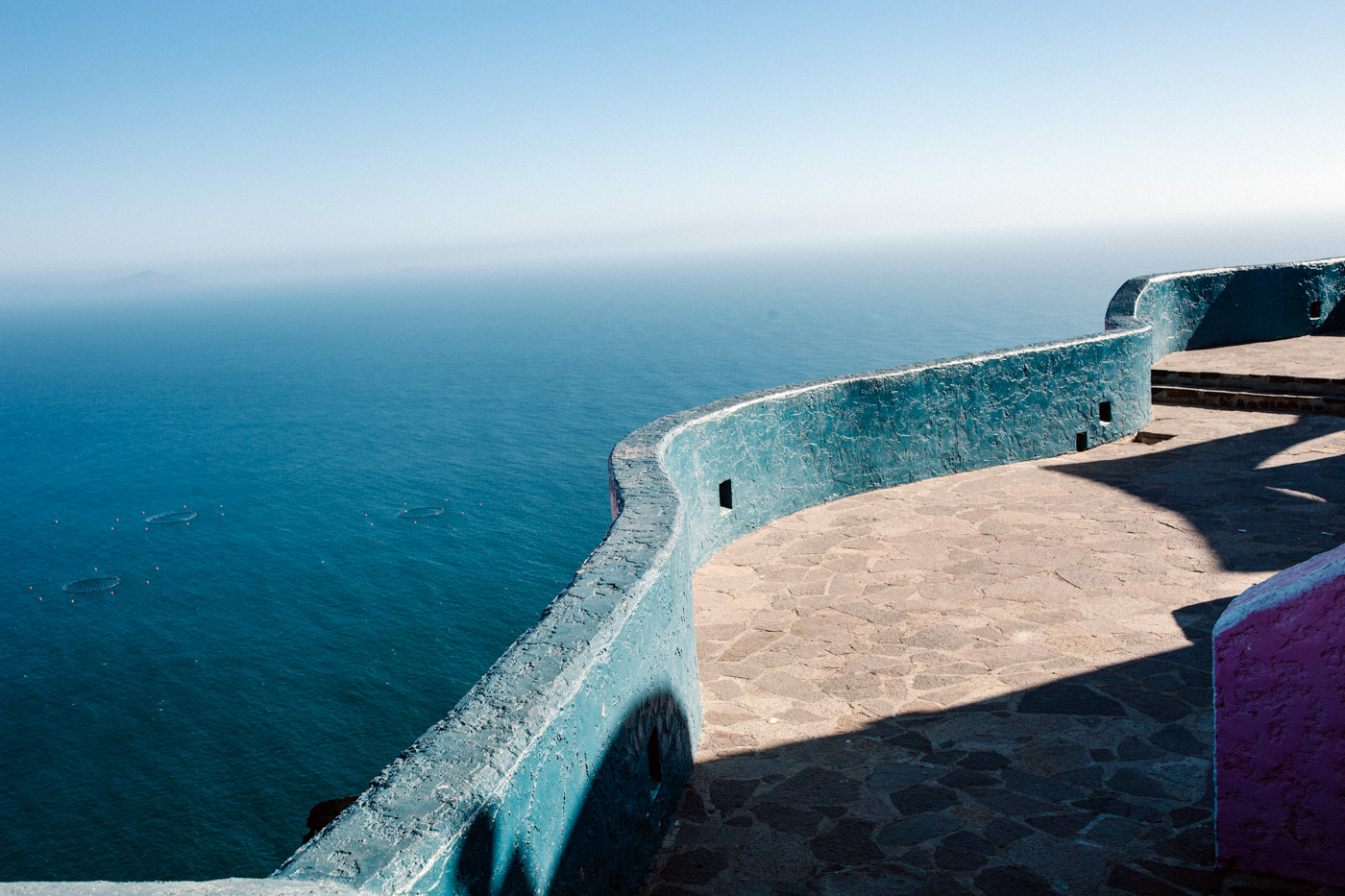
Culinary Art School is now regarded as one of the best schools in the country. At least 1,350 students have received a degree in culinary arts, with hundreds more receiving sommelier certifications and diplomas ranging from pastry to healthy cuisine. In a country where many of the culinary programs are European based, Culinary Art School stands out for offering the only masters program in Mexican cuisine. Most of the students are from the region, but aspiring chefs come from all corners of Mexico and currently about twenty percent are commuter students, meaning they live in the U.S. (tuition is about half the average cost of programs stateside, and they also offer scholarships). No longer a converted house, in 2010 one of the city’s top architects took corrugated steel, wood and concrete to turn a vacant lot into a state-of-the-art cooking oasis on the edge of Mexico.
“There definitely was a feeling of closeness when we started, like we were a collective,” says González, reflecting on the early days when sixteen students and a few professors were embarking on new territory together. “What we’ve tried to do since then is turn that collective into a community.”
Culinary Art School’s trajectory makes it a competitive program, but existing at a cultural crossroads might be what has made it most successful at fueling a food movement. The school’s three-year program requires students to work in restaurants at least every six months—first in Mexico, then abroad—and in the last year, at an internship location of their choice. They’ve sent students to thirty countries, to two and three Michelin-star restaurants across Europe, and to places like Noma and Pujol. At home, students are exploring Baja through a curriculum with a uniquely high ratio of practice to theory, immersing themselves with the area’s ranches, fishermen, cheesemakers and wineries.
The program creates a constant rotation of students finding context for Baja in Mexico’s foodways, pride in its ingredients, and applying their influences and training back at home. González describes the waves of students coming home to open restaurants and businesses, fertilizing the soil for future generations of chefs to blossom: “The work these students are doing benefits the entire region.”
——
Heading east from Tijuana, the highway follows the border—a rust colored fence that looks like a mechanical centipede snaking along the hills toward Tecate. In the odd mix that could only happen in a semi-industrial border city, Tecate’s most iconic landmarks are its namesake beer factory shadowing over downtown and Rancho La Puerta, an oasis and spa on the outskirts that has lured foreigners for eighty years with indigenous legends of sacred mountains and a farm-to-table experience.
Reyna Venegas, who graduated from Culinary Art School in 2010, is the executive chef at Rancho La Puerta and co-owns downtown restaurant Amores with her husband, Marcelo Hisaki. Amores is one of the few modern restaurants in this gateway to the Valle de Guadalupe, sharing whimsically plated dishes that represent her partner’s Japanese-Mexican heritage and their mutual passion for Baja’s seasonal ingredients. She harvests for Amores from Rancho La Puerta’s gardens collecting rows of cherry tomato varieties, the fruits of a magnificent mulberry tree, flowers the color of Baja’s electric sunsets, and purple carrots sprouting flowers she can’t wait to sprinkle on her vegan carrot cakes. It’s here where she got her first job as an eighteen-year-old hostess, and now at thirty helms the kitchen while her husband runs Amores (although she still manages the business side).
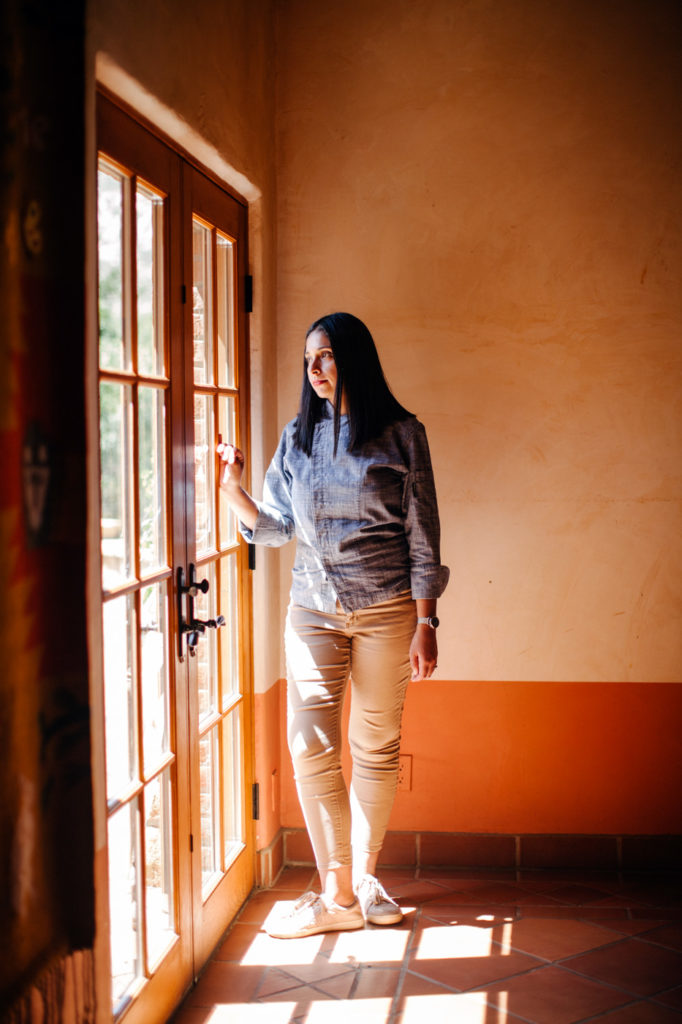
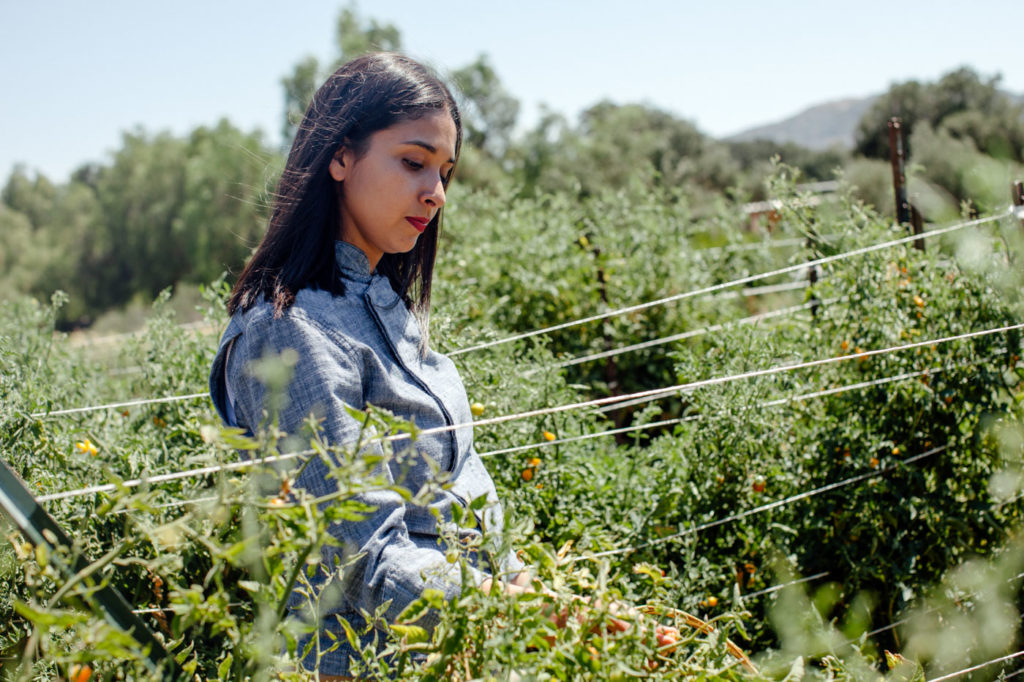
Like other border-born chefs, Venegas credits her Tecate upbringing for giving her a language and cultural familiarity that helps her understand what her U.S. tourist clientele (about half) wants. But in 2013 when Amores opened she was still pushing a cultural change at home, where eating habits were influenced by the fast food culture of nextdoor. “People thought we were crazy for doing a seasonal menu and not offering much meat,” she says.
The goal of leaving the area for internships in Monaco and Mexico City was to learn and “return to help this area grow and realize its potential,” says Venegas. She’s taken numerous interns under her wing, and the chef de cuisine at Amores started as a Culinary Art School intern. The restaurant has two other alums working for them as well.
“There’s only one chef, but you need twenty people to make a village; and in order for it to grow, you need a lot of people who speak the same language,” says Chef Denise Roa, Venegas’ mentor who runs the resort’s cooking classes and café. She also used to teach at Culinary Art School and now welcomes in classes visiting the ranch for hands-on learning.
“That language is important for purveyors. Before, the best products would sell straight to the U.S. and Japan,” she says. But after Culinary Art School was founded, chefs in the area upped their standards and demanded better products for their menus.
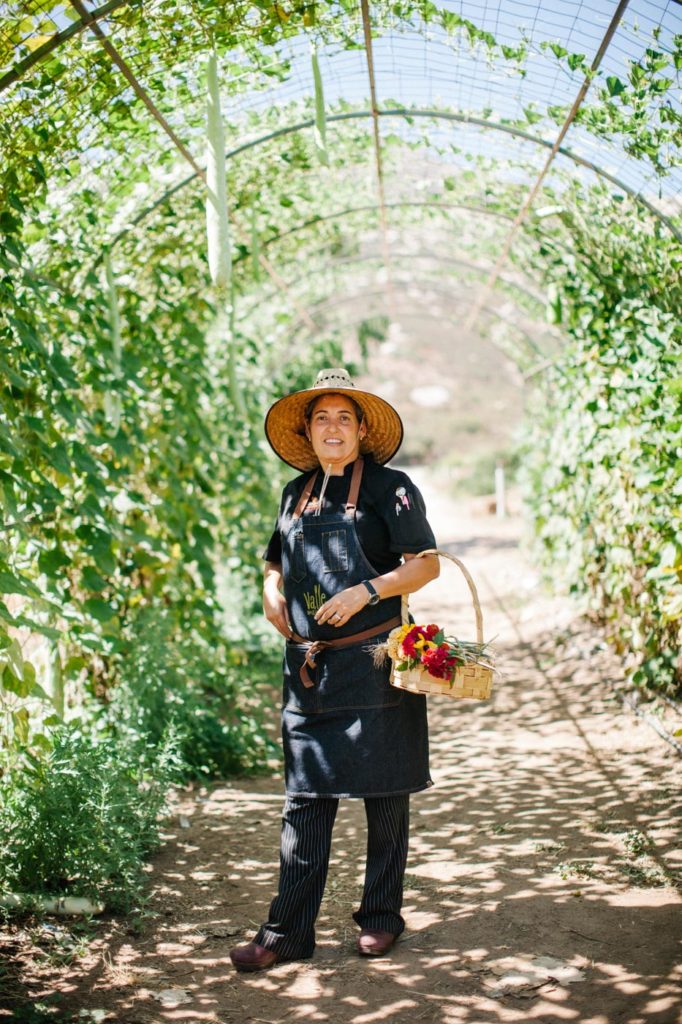
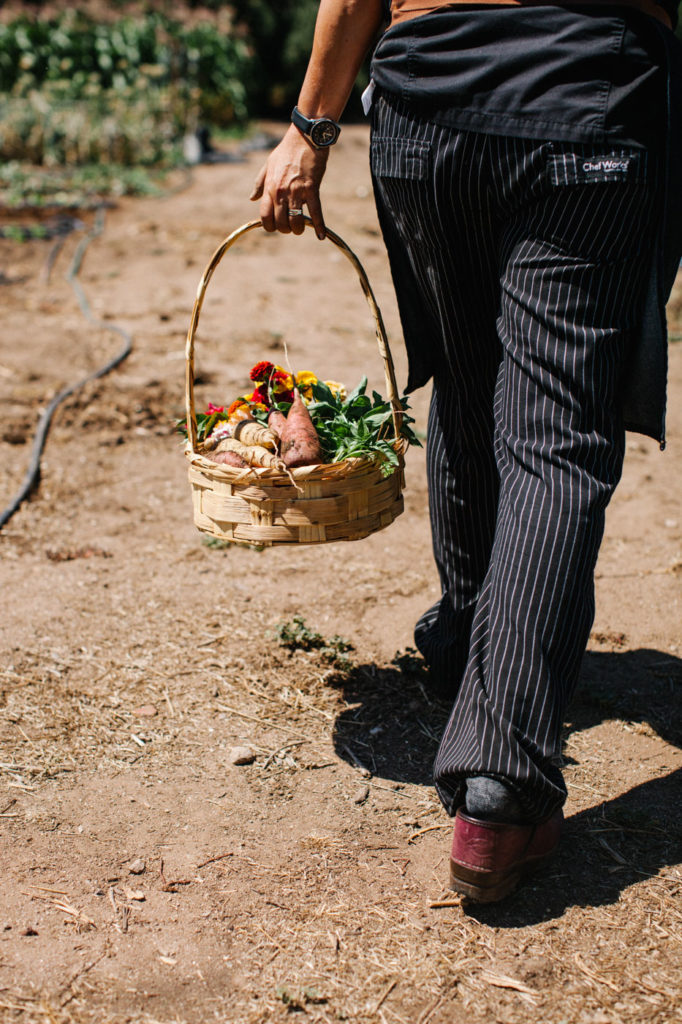
——
About an hour south of Tecate is the Valle de Guadalupe, where Miriam Moreno, another Culinary Art School alumni samples goldish green grapes from the forty-year-old vines hanging above her open air restaurant, Brote.
Every morning Moreno leaves her home in Ensenada for the fish market, a narrow passageway of vendors hawking coveted ingredients from Baja’s two coastlines: piles of deep maroon smoked marlin, crates of chocolate clams, metallic mosaics of shrimp, and local fish. At six months pregnant (brote means to bud or sprout) she sends her husband to do the buying, but she trusts her purveyors: one stand that’s been sourcing from local fishermen for three generations, and another with tanks of geoduck, the phallic-appearing saltwater clam, which locals refer to as almeja chiluda or well hung clam.
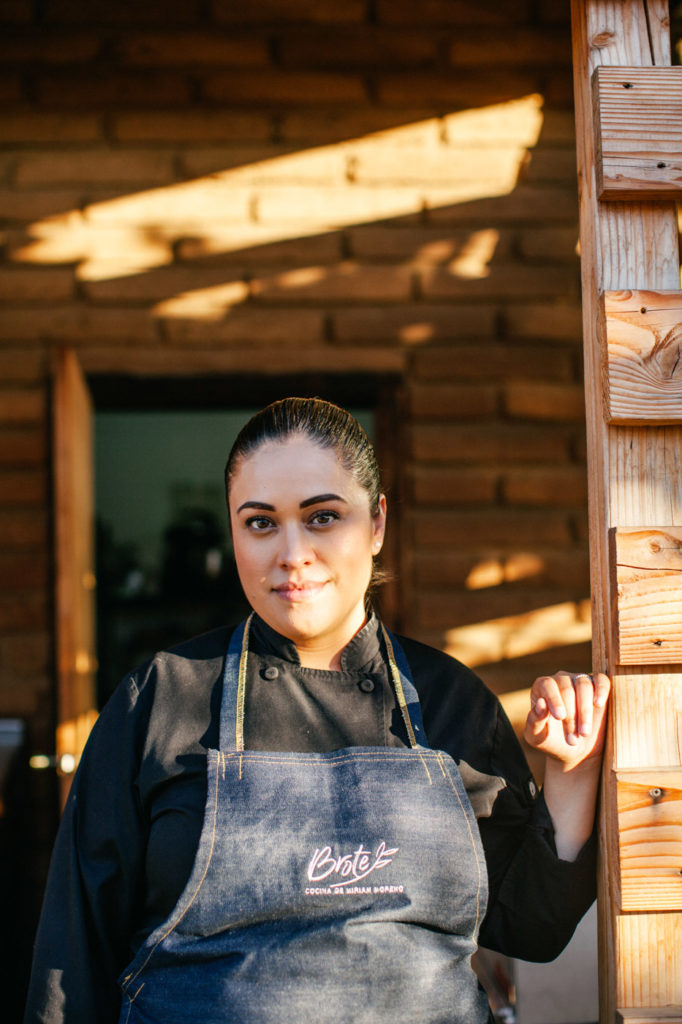

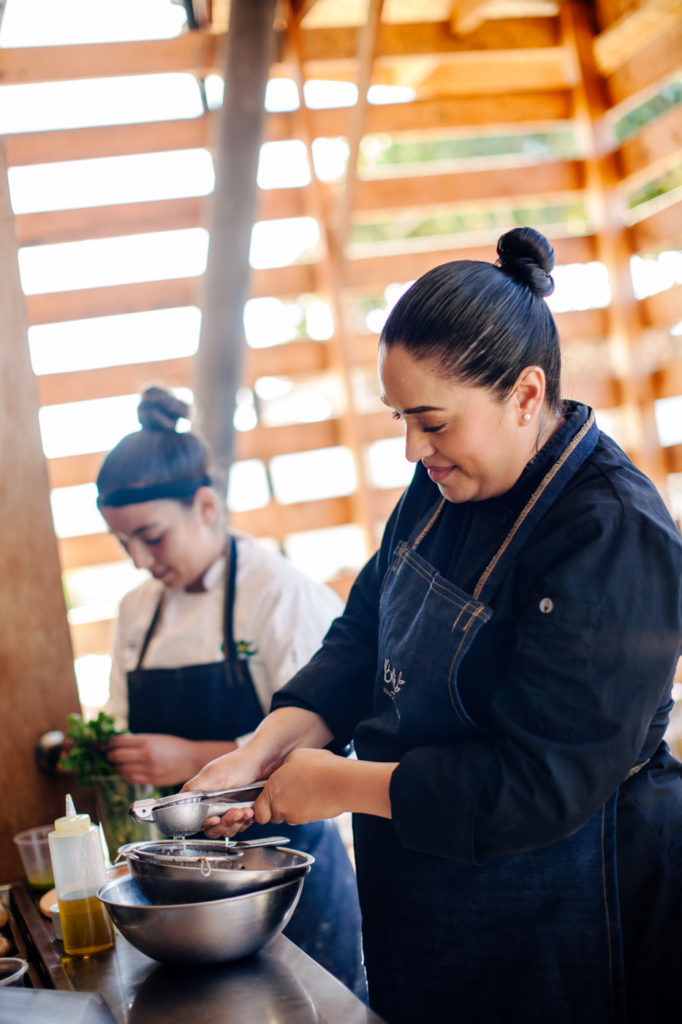
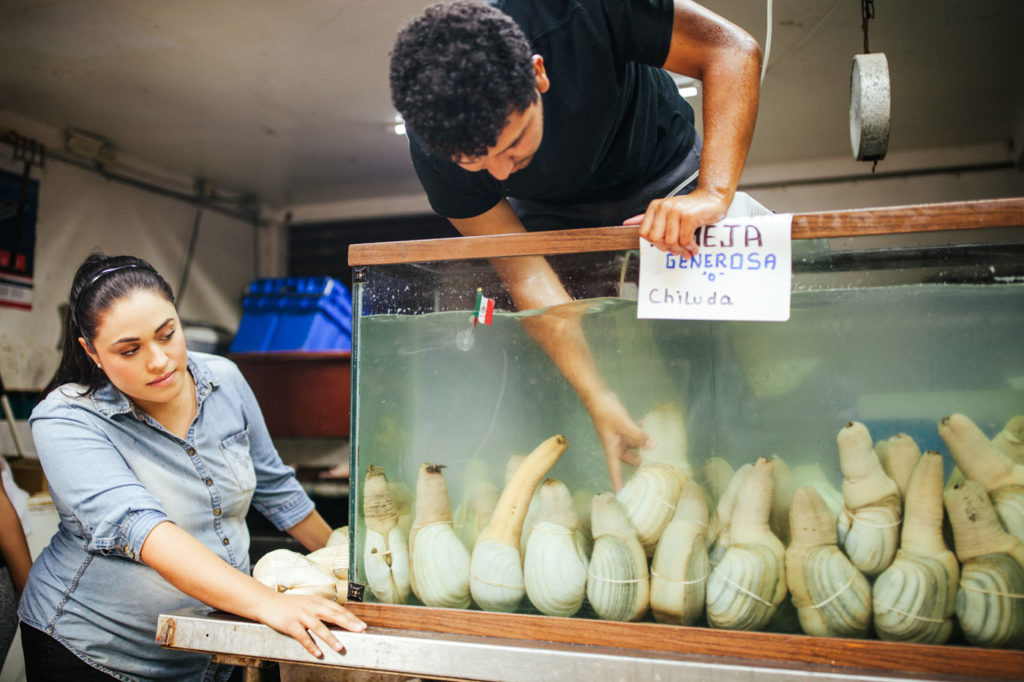
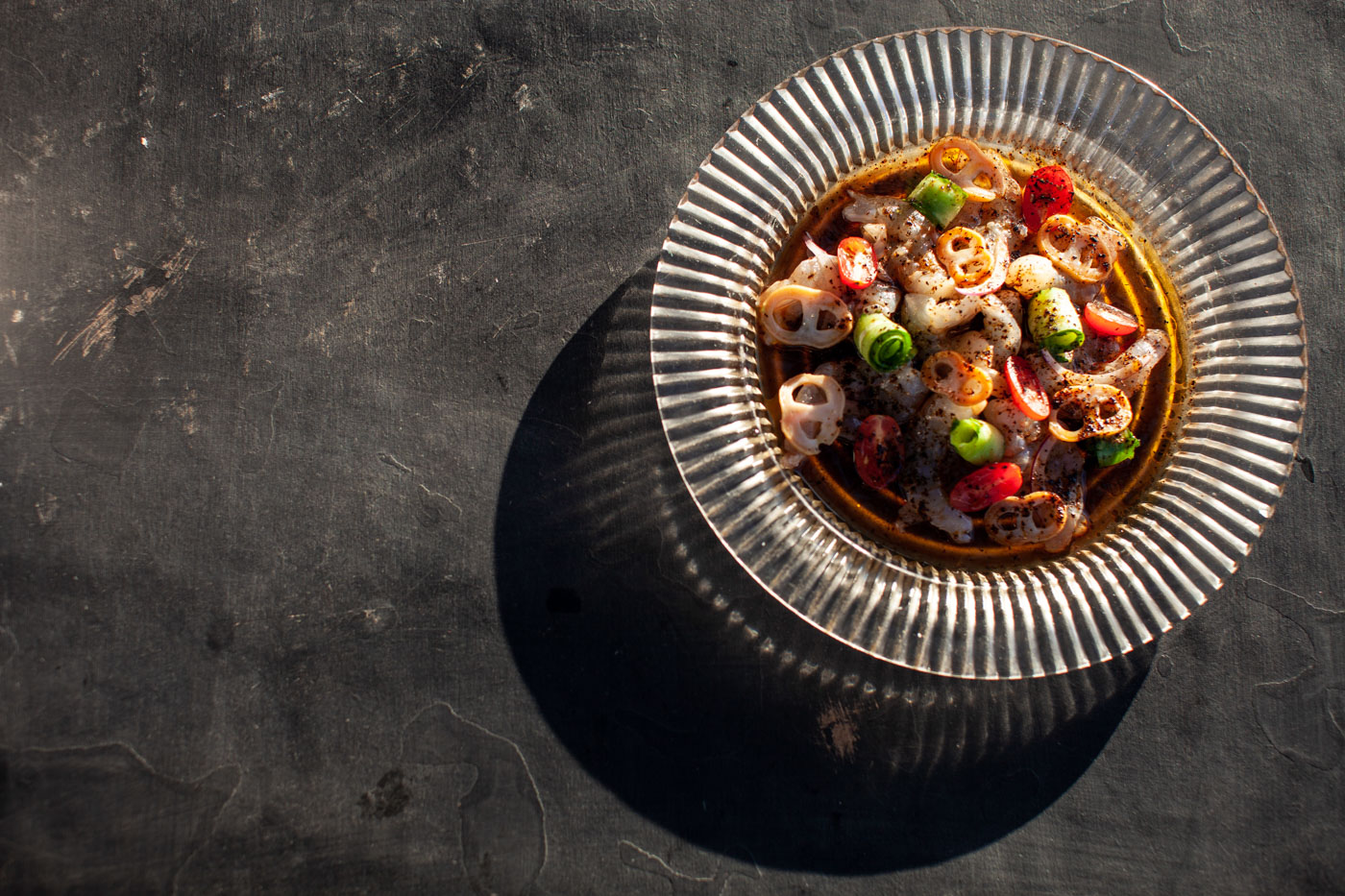
Brote overlooks the Torres Alegre vineyards, guarded by bird-repelling tinsel ribbons that sparkle in the wind. Winemaker Victor Torres has legendary status in the Valle de Guadalupe: he was making wine here almost before anyone else and holds a PhD in oenology from the University of Bordeaux. The wines, which include some of Mexico’s most expensive, are representative of the valley’s reputation for lawlessness when it comes to varietals and blends. Instead of typical pairings, Moreno built the menu so each dish could pair with any of the wines, although she likes serving the aguachile with a deep pink, bitter rosé blend of nebbiolo, cabernet sauvignon and grenache.
Moreno grew up in Tijuana with a mom from Mexicali and a dad from Ensenada, meaning family reunions were stocked with carnitas and garnachas, or aguachiles and lobster salads. “Still, when I went to work in the center of the country, people would ask, ‘What dishes do you have in Tijuana?’ We were made fun of because we didn’t have moles or other iconic dishes,” she says. “I never felt insecure, but it did make me think, what dishes are we?”
The answer lies in Moreno cooing over her trellis of grapes, Venegas searching for the perfectly ripe jujube, Ibarra foraging for urchin and goose barnacles in Ensenada. “Baja is a cuisine of products,” she realizes. It’s also a cuisine of the flavors she sampled in the immigrant communities of San Diego and in her family meals that span the traditions of Northern Mexico. It’s a cuisine formed by the school instructors and directors who asked her, “How are you going to put your own stamp on your food?”
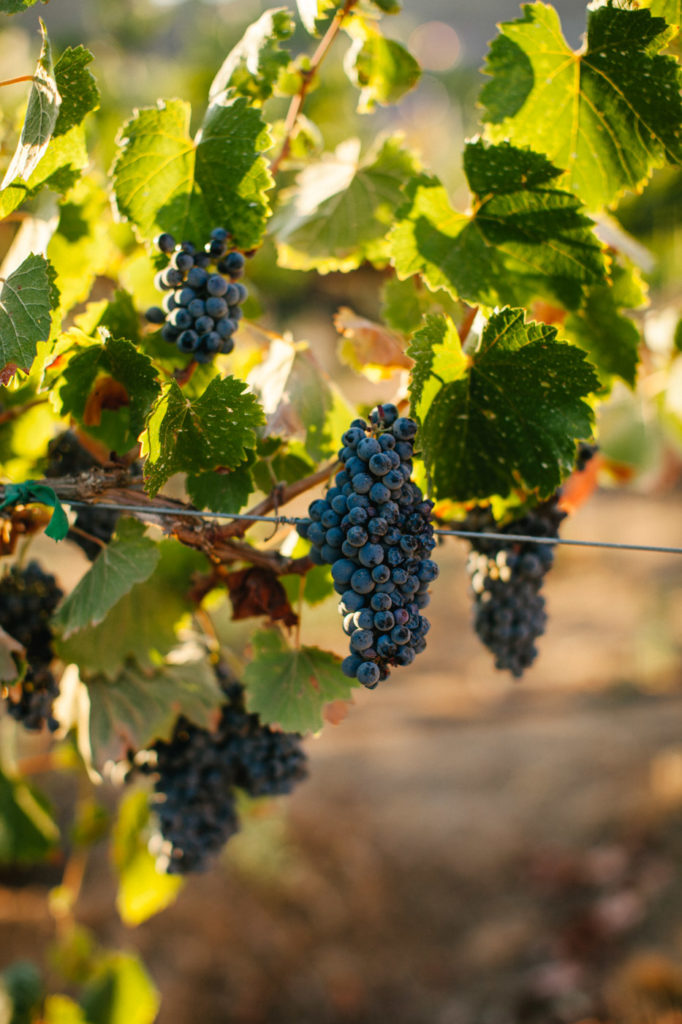
——
To get to and from Baja by land, U.S. travelers have to pass through a city with migrants who wait on asylum in inhumane conditions and deportees holding signs among the car lines asking for change to get back to their homes in central Mexico. As the U.S. immigration system continues to tighten the contrast between a trendy and often opulent food scene, communities in desperate situations widens. When the migrant caravan came to Tijuana in November of last year, several chefs sprang into action, joining the World Central Kitchen’s emergency efforts to provide meals. Ibarra was one of them.
Ten years earlier, during the heat of cartel violence in Tijuana, Ibarra’s father came to Culinary Art School, pulling him out of class to pack his things and join the rest of the family as they fled after a violent attack on a family member. The next day, his younger brothers (all U.S. citizens except for him) were scattered across the country. Ibarra moved in with family in Cherokee, North Carolina, and you can hear the remnants of that period in the country music twanging through his speakers. “I was privileged,” he admits, to have a visa and the means to comfortably escape, but “the feeling of one day everything you know changing” came back to him as he watches Central American families descend on the city.
“When this big caravan of immigrants came through Mexico, there was a lot of judgement from people here and I think they forgot that Tijuana was made almost completely out of immigrants,” he says.
Ibarra now works with This is About Humanity, a Los Angeles-based organization raising awareness and funds for organizations supporting migrants at the border. Ibarra is clearly passionate about the cause, but he’s also a social media savvy chef of the times and organizing high-priced fundraising dinners in Malibu folds neatly into his brand as a new wave border chef. He communicates mostly in English on social media, invites L.A. chefs for guest dinners, and pops up at restaurants in San Diego. It’s an interesting glimpse of how the definition and representation of border food will continue to evolve.
As Ibarra heads into his fourth year at Oryx Capital, he’s considering project offers on the other side of the border. Opening a place on the other side is as big of a personal challenge for Ibarra as it is to our current political climate. “I want to do it to prove a point,” he says. “Because the beautiful part about food, humanity and creativity is there are no borders to them.”






Our comments section is for members only.
Join today to gain exclusive access.